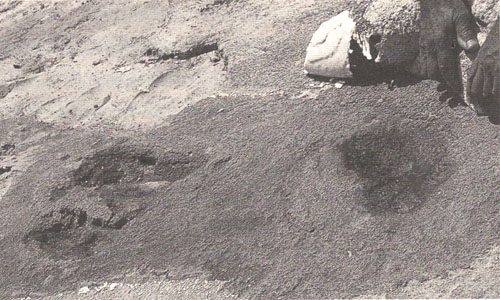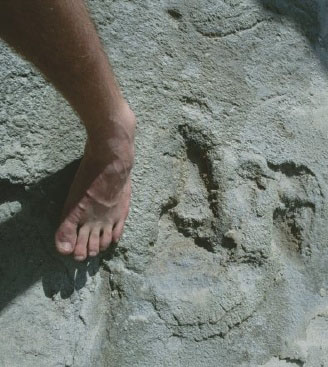
Langebaan Lagoon, South Africa

Langebaan Lagoon

|
| Fossilized footprints at Langebaan Lagoon, South Africa |

|
| Close up of one of the prints at Langebaan Lagoon |
Part of Kuban's Paluxy web site
In 1997 a sequence of human footprints, consisting of two complete prints and a partial third, was discovered by field geologist Dave Roberts on the shore of Langebaan Lagoon, just North of Cape Town, South Africa in hardened sand-dune deposits dated at approximately 117,000 years old. The prints have been documented , cast, and preserved by the Museum of South Africa, where some are now on display. Unfortunately, the prints are not very distinct, with only hints of toes. Similar prints preserved as natural casts (infillings of the original track depressions) were found nearby in the 1960's at Nahoon Point, East London, South Africa.
Human-like prints have been found in even older sediments, such as the "Laetoli prints" in hardened volcanic ash in Tanzania dated at over 3 million years. However, they have been attributed to hominids (human ancestors), whereas the Langebaan Lagoon footprints are evidently the oldest prints reliably ascribed to fully modern humans.
Young-earth creationist Jeff Brenner (2006-2012) includes the Langebaan Lagoon tracks on his site devoted to anomalous footprints. Brenner shows a photo of a distinct human trackway in association with his article, but based on comparisons with the photos in scientific reports on the find, it cannot be the Langebaan Lagoon trackway. Indeed, it appears to be a photo of human fresh tracks in sand. In any case, there is nothing problematic or anomalous about finding human tracks in strata over 100,000 years old, since this is within the timespan when human remains and artifacts are known. The only aspect of the finding some creationists would dispute is the age of the dunes (since most strict creationists maintain the earth itself is less than 10 or 15 thousand years old).
References
Avery, Graham, 1998, South African Museum web article: "Human footprints from the langebaan lagoon in the west coast national park"
Brenner, Jeff, 2006. Website article at: www.bennerwc.com/ancientman/02_langebaan.html. In 2007 the website was removed.
Deacon, H.J. 1966. "The dating of the Nahoon footprints." South African Journal of Science 62: 111-113.
Gore, R., 1997. "The dawn of humans. Tracking the first of our kind." National geographic magazine 192 (3): 92-99.
Hunt, Steven, 1997, "Oldest human footprints ever discovered - 117,000 years old."
Mountain, E.D., 1966. "Footprints in calcareous sandstone at Nahoon Point." South African Journal of Science 62: 103-111.
Roberts, D. & Berger, L.R., 1997. "Last Interglacial (c. 117 Kr) human footprints from South Africa." South African Journal of Science 93(8): 349-350. PDF version on web at: http://www.profleeberger.com/files/langebaanfootsajs1997.pdf